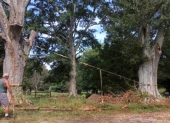Have all the Permies folks who fell trees with a chainsaw seen this technique, as shown and explained in this video?
The general advice about preparing for the tree felling, in the first portion of the vid, is very good. But what’s different from the traditional way of cutting that many of us learned is that with a plunge cut and subsequent maneuvers of the blade you
leave a portion of the back of the tree as you create the hinge. Hence, in the video, you can see the bar come out the other side of the trunk on that cut.
Here’s the part that you could miss when you watch the cutting portion of the vid: What keeps the kerf from ever pinching your blade and jamming the chain is the remaining bit that he calls “the strap”. The strap is a little portion of the outer trunk -
allowed to remain intact opposite the face notch, until you finally cut it to allow the tree to drop. He calls this very last cut, where the strap is severed, “releasing the back”.
With the old hinge method you made your face notch and then just cut in from the very back, toward the hinge. By comparison with the new method, it could be more trouble to place and drive wedges if needed, and you had less control over positioning of the falling tree. This new approach keeps the kerf open (not allowed to be closed by the weight of the tree or influence of wind). It enables you to put wedges in easily, if you feel they’re required. Also allows ample opportunity to get well out of the way when the tree begins to fall over, after you’ve cut the strap.
Some people call the “strap” the “trigger” - because when it’s finally cut, it’s like triggering the drop of the tree.








